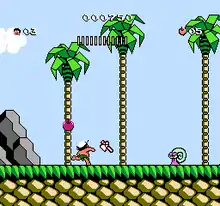Adventure Island 3
Adventure Island 3 (高橋名人の冒険島Ⅲ, Takahashi Meijin no Bōken Jima Surī, "Great Takahashi's Adventure Island III") is a side-scrolling platform game published by Hudson Soft that was originally released for the Nintendo Entertainment System in 1992. It is the third game in the Adventure Island released for the NES, following Adventure Island II. Unlike the first two games in the series, the NES version was never released in Europe. A portable version was also released for the Game Boy in 1993 titled Takahashi Meijin no Bouken Jima III, renamed to Adventure Island II: Aliens in Paradise outside of Japan.
| Adventure Island 3 | |
|---|---|
 Cover art by Greg Martin | |
| Developer(s) | Now Production |
| Publisher(s) | Hudson Soft |
| Designer(s) | J. Koyanagi |
| Programmer(s) | Takeshi Hirakawa |
| Artist(s) | Katsuya Jitto |
| Composer(s) | Miyoshi Okuyama Hirohiko Takayama |
| Series | Adventure Island |
| Platform(s) | Nintendo Entertainment System, Game Boy |
| Release | NES July 31, 1992 (Japan) September, 1992 (NA) Game Boy (Adventure Island II) February, 1993 (NA) February 26, 1993 (Japan) 1993 (Europe) |
| Genre(s) | Platform, side-scroller |
| Mode(s) | Single-player |
Gameplay

Higgins can crouch, an ability he did not have in the previous NES games. However, he loses the ability to backtrack during a stage. Unlike the previous game, the boss does not move to a different stage when the player loses a life.
The inventory system from the second NES game is still present, but this time he has eight items to choose from instead of just five. Higgins has a fifth dinosaur friend who can help him out: a triceratops (summoned by a star card) that can defeat enemies with his rolling attack. The other new items include a boomerang weapon that can be used as an alternative from Higgins' traditional stone axe weapon, and a crystal that provides Higgins with one hitpoint when he begins a stage.
There are different hidden rooms as well, such as a treasure room where Higgins can choose a new power-up, a surfing bonus round, a room containing a crystal (with an option to continue the level or skip it), and a room with the option of skipping a boss (which will also skip the stage) or not.
Version differences
The Game Boy version features a password system, as well as an interactive overall map that allows the player to revisit previously completed stages to find new paths.